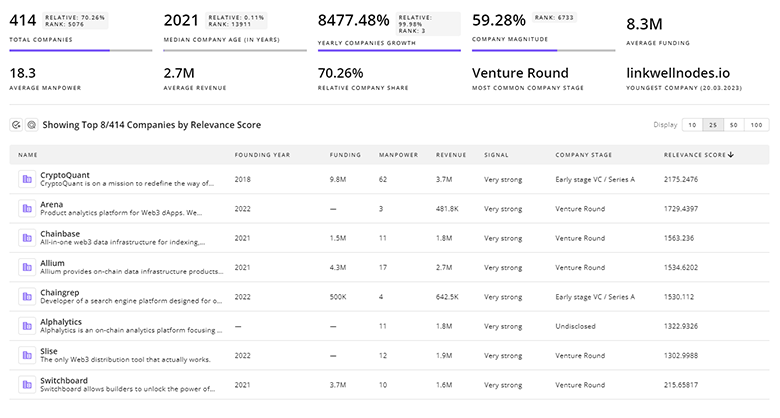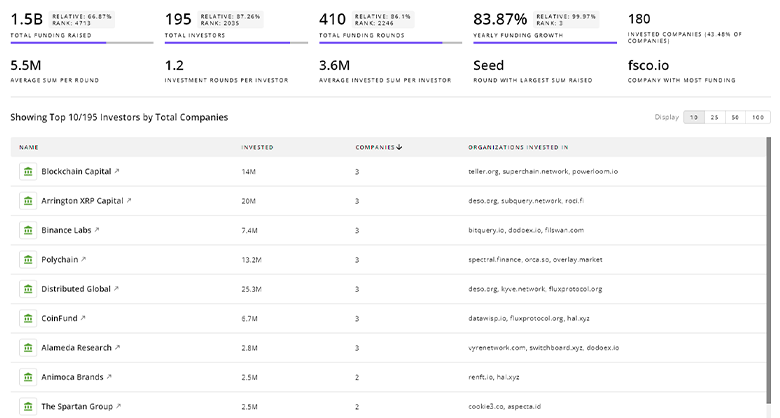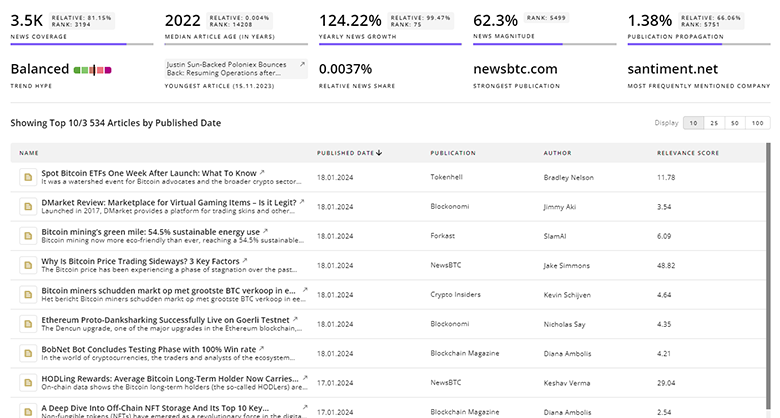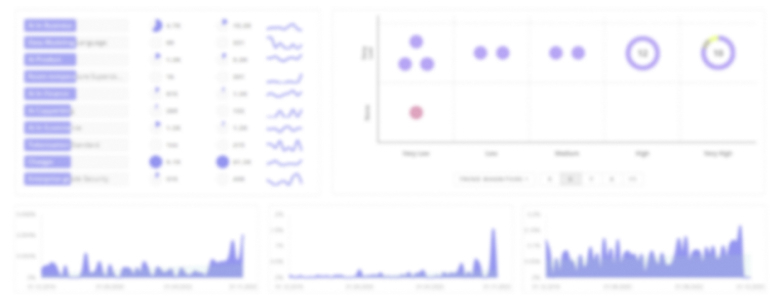
Foodtech Report
: Analysis on the Market, Trends, and TechnologiesThe foodtech market is large but uneven: the internal data shows a global foodtech market size of USD 210.9 billion in 2024 with an 8.2% CAGR, while capital flows have re-rated—early-era volume of deals collapsed and investors now concentrate on fewer, higher-impact targets (global AgriFoodTech funding fell ~73% from $61.2B in 2021 to $16.1B in 2024), producing a capital environment that favors scalable biotech, circular-ingredient, preservation, and automation solutions over consumer apps.
This article was last updated 69 days ago. If you find any info is missing, let us know!
Topic Dominance Index of Foodtech
The Dominance Index of Foodtech looks at the evolution of the sector through a combination of multiple data sources. We analyze the distribution of news articles that mention Foodtech, the timeline of newly founded companies working in this sector, and the share of voice within the global search data
Key Activities and Applications
Alternative protein production (precision fermentation, mycelium, cultivated cells) — companies convert microbial or cell processes into functional ingredients and whole-cut products to meet demand for lower-impact proteins and to address supply volatility.
So what: With fewer but larger rounds, investors prefer platforms that can scale cost curves (fermentation/bioreactors) to reach unit economics compatible with mainstream CPG, making platform CDMOs and process-intensification firms high-priority targets.
Waste up-cycling and ingredient reclamation — converting processing by-products (fruit pits, brewer's yeast, etc.) into oils, proteins, flavor ingredients or feedstock to close value loops and improve margins.
So what: Upcycling reduces raw material expense and carbon footprint while creating differentiated, sellable ingredient lines that attract sustainability-focused buyers and regulators.
Shelf-life extension and cold-chain resilience (aseptic and advanced packaging, data-driven remaining-shelf-life prediction) — technologies that extend market reach and reduce spoilage losses (critical in logistics and retail).
So what: Extended shelf life directly converts to lower waste and higher on-shelf yield; in a constrained capital market, predictable waste reduction delivers measurable ROI and accelerates adoption.
Automation & robotics for processing, kitchen operations, and quality inspection — modular robotic systems, clean-in-place design, and RaaS models deployed to solve labor shortages and consistency issues (SavorEat ).
So what: Robotics converts fixed labor risk into capital expense; companies that offer subscription/maintenance economics (RaaS) de-risk customer procurement and speed adoption.
Data and AI for consumer insights, R&D acceleration, and traceability — consumer trend platforms, recipe/assortment optimization, predictive quality analytics and blockchain traceability for compliance (Tastewisefood analytics).
So what: Insight layers shorten product development cycles and increase hit-rate for launches; traceability layers reduce recall costs and open procurement channels with retailers demanding provenance.
Emergent Trends and Core Insights
Capital concentration on deep tech and circularity: investor behavior shows fewer deals but larger medians (median deal size increased) and top cohorts still attract large aggregate capital, privileging companies with measurable environmental or cost outcomes (scale / unit economics) (FoodTech 500 findings; internal funding signals).
So what: Founders must quantify environmental and unit-cost impact in KPIs to win limited capital.
Food + climate tech convergence: patent and process filings emphasize renewable-energy integration into processing, food storage/conservation, and by-product reuse, with China as a major patent filer in processing/mitigation categories (internal patent summary).
So what: Solutions that lower energy intensity of processing or cut logistics emissions enjoy both policy tailwinds and procurement preference.
Platformization over point solutions: the market favors integrated stacks (analytics + supply chain + on-premise systems) rather than single features; platform players build defensibility through data network effects ([Company Landscape Report synthesis]).
So what: Niche tech providers should plan integration pathways (APIs, partnerships) to plug into larger platform ecosystems.
Traceability and regulatory tech ascendancy: global regulatory pressure and retailer demands accelerate adoption of immutable traceability and digital food-safety workflows (TE-FOOD InternationalFoodtraze).
So what: Traceability is becoming a prerequisite for large B2B contracts and export market access.
Shifting consumer tech mix: consumer-facing delivery and app plays lost prominence versus ingredient, processing, and biotech innovation—demand moved from convenience apps to systemic resilience and sustainability (FoodTech 500 synthesis; THRIVE Top 50).
So what: Business models that rely purely on consumer-app growth must re-price go-to-market and investor expectations.
Technologies and Methodologies
- Precision fermentation and scalable downstream processing (bioreactor design, media recycling) for low-cost functional proteins and specialty molecules.
- Aseptic and advanced packaging (room-temperature shelf stability via sous-vide aseptic packaging, retort and MAP) to extend distribution reach and reduce cold-chain footprint.
- AI/ML-driven consumer analytics and generative workflows for R&D acceleration and route-to-market optimization (trend surfacing, recipe optimization, demand forecasting).
- IoT + cloud monitoring for cold chain visibility and predictive shelf-life scoring, coupled with decision platforms for donation/discounting or reprocessing.
- Modular robotics, CIP-compatible designs and RaaS commercial models for commercial kitchens and high-volume production lines (Newtech Intelligent Automation).
- Circular-economy engineering for upcycling feedstocks and by-products into differentiated food ingredients (mechanical separation, enzymatic conversion, novel extraction) (Green Eco Technologies).
Foodtech Funding
A total of 6.4K Foodtech companies have received funding.
Overall, Foodtech companies have raised $240.9B.
Companies within the Foodtech domain have secured capital from 23.0K funding rounds.
The chart shows the funding trendline of Foodtech companies over the last 5 years
Foodtech Companies
Kern Tec — Austrian upcycling specialist that converts stone-fruit pits and other by-products into high-value oils, proteins, and ingredient streams; the company reports >1,000,000 kg upcycled and invests in scaling industrial processes to serve food and cosmetic markets, positioning it where waste becomes margin and CPG clients seek sustainable inputs.
IXON Food Technology — Hong Kong-based developer of advanced sous-vide aseptic packaging allowing shelf stability at room temperature for up to two years without preservatives; the tech targets export and retail channels where cold chain costs and access limit product reach.
YDLabs — fermentation CDMO focused on Agri-Foodtech scale-up from lab to 1,000L; YDLabs offers upstream and downstream services that accelerate process commercialization for microbial protein and ingredient producers, reducing capex and technical risk for clients.
Foodtel — Sweden-based platform that pairs cold-chain monitoring with scientifically validated remaining-shelf-life algorithms and an integrated marketplace/donation flow; offers operators a decision system for temperature deviations that converts risk into commercial and social value.
Tempty Foods — Danish fermentation/mycelium ingredient company producing mycelium-root ingredients with a focus on taste and texture rather than imitation-meat narratives; targets product developers seeking differentiated plant-rich bases with favorable sustainability metrics.
Uncover actionable market insights on 29.9K companies driving Foodtech with TrendFeedr's Companies tool.

29.9K Foodtech Companies
Discover Foodtech Companies, their Funding, Manpower, Revenues, Stages, and much more
Foodtech Investors
Get ahead with your investment strategy with insights into 17.7K Foodtech investors. TrendFeedr’s investors tool is your go-to source for comprehensive analysis of investment activities and financial trends. The tool is tailored for navigating the investment world, offering insights for successful market positioning and partnerships within Foodtech.

17.7K Foodtech Investors
Discover Foodtech Investors, Funding Rounds, Invested Amounts, and Funding Growth
Foodtech News
TrendFeedr’s News feature offers access to 30.4K news articles on Foodtech. The tool provides up-to-date news on trends, technologies, and companies, enabling effective trend and sentiment tracking.

30.4K Foodtech News Articles
Discover Latest Foodtech Articles, News Magnitude, Publication Propagation, Yearly Growth, and Strongest Publications
Executive Summary
Capital and attention in foodtech have moved from volume to selectivity: investors now favor companies that demonstrate measurable reductions in cost, waste, or emissions and clear scalability paths. Practically, this elevates platform CDMOs for fermentation, upcycling processors that convert waste into margins, advanced preservation and traceability stacks that protect shelf value, and automation vendors that convert labor risk to predictable cost. For strategic leaders and investors, the actionable axis is simple: prioritize assets that link science (fermentation, bioprocessing, materials) to deployable systems (packaging, robotics, IoT) and that can prove dollar-per-tonne environmental or margin impact in commercial customers' P&Ls.
Have expertise in trends or technology? Your input can enrich our content — consider collaborating with us!












